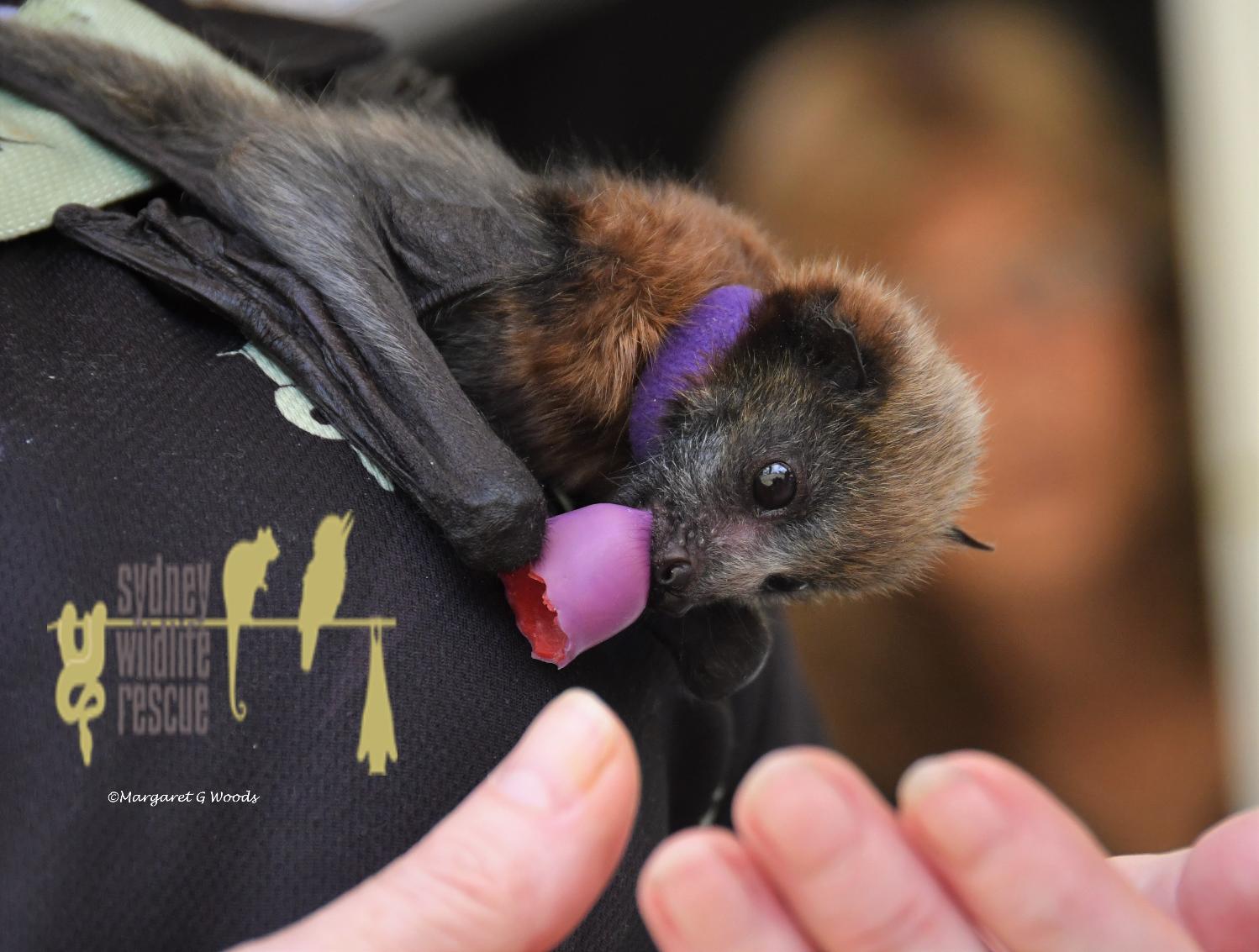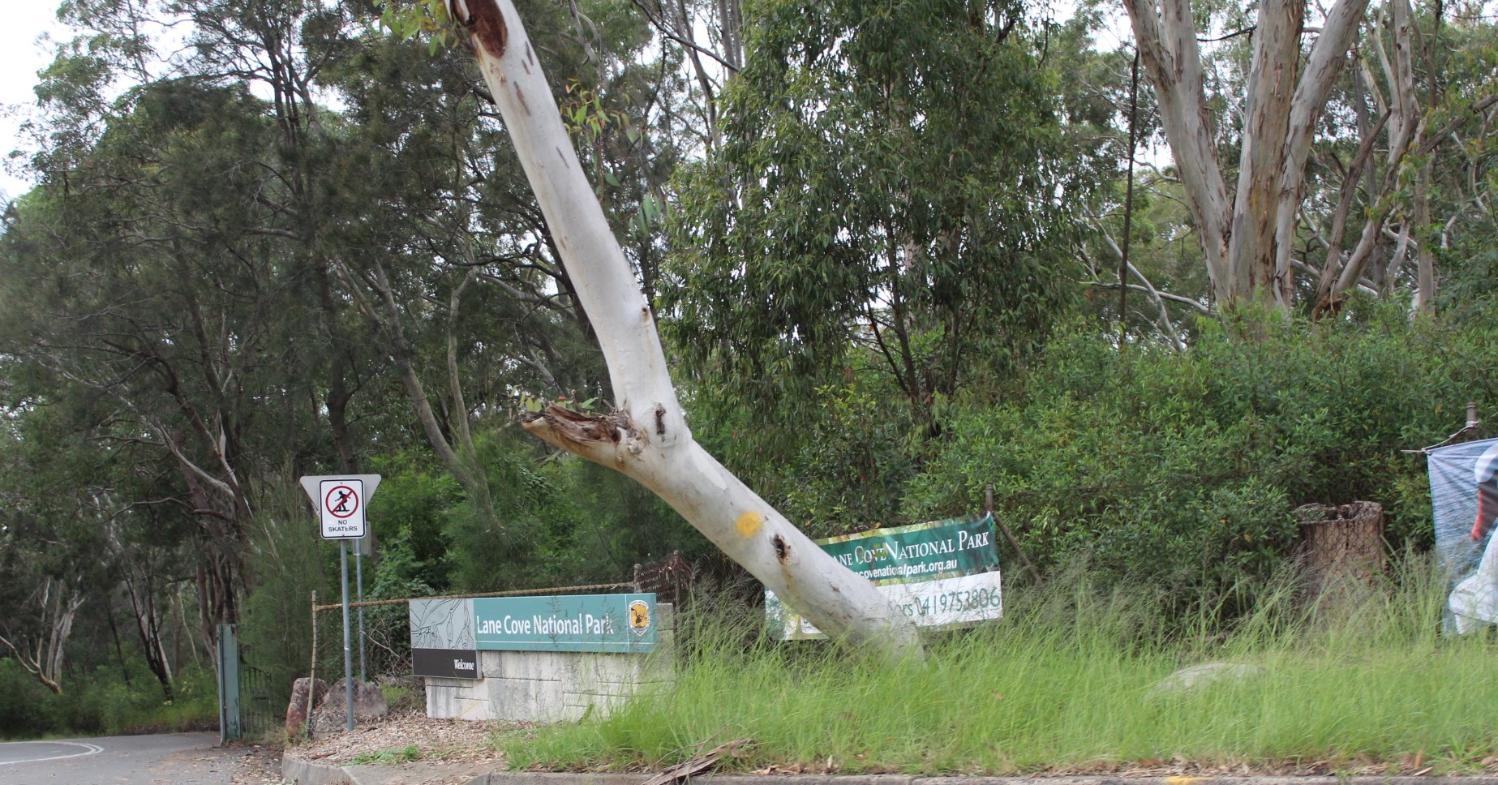May 23 - 29, 2021: Issue 495
Kukundi Wildlife Shelter
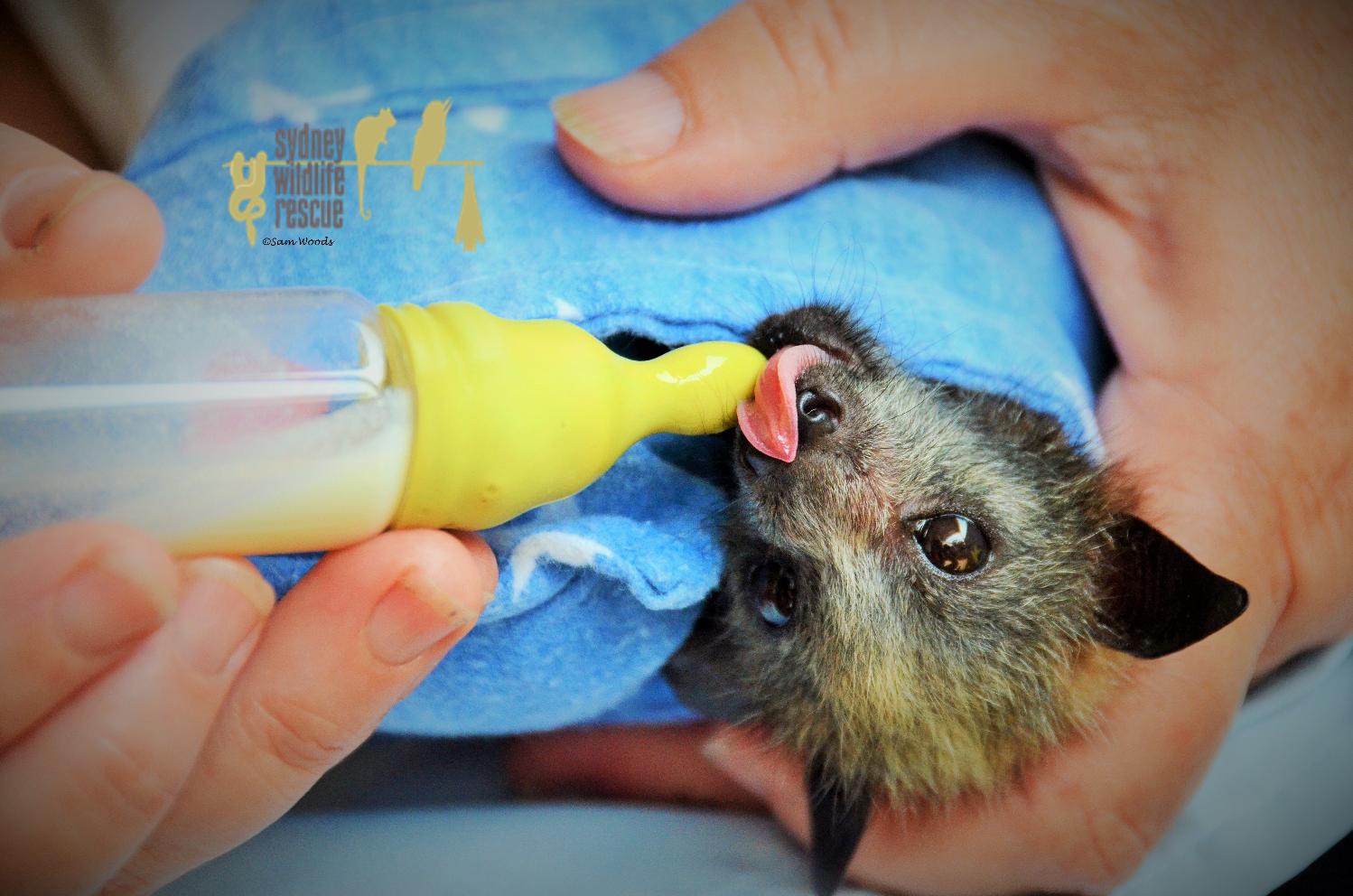
The Kukundi Wildlife Shelter was originally a small zoo established by the park trustees in Lane Cove National Park. The park is within the traditional lands of the Guringai people. Over the years the shelter changed to a zoo displaying animals native to the area, and more recently into a facility for the care of injured wildlife before release back into the wild. At present only flying foxes are looked after there and this includes Grey Headed, blacks and little reds.
The word ‘Kukundi’ has a meaning of ‘kookaburra’ and is from the Iyura dialect of the Sydney Language. [1.] The Dharug language, also written Darug and Dharuk and also known as Eora (Iyora and Iyura) or the Sydney language, is an Australian Aboriginal language of the Yuin–Kuric group that was traditionally spoken in the region of Sydney, New South Wales. It is the traditional language of the Darug.
The National Parks and Wildlife Service is assisted in the management of Kukundi by Sydney Metropolitan Wildlife Service (SMWS) involved in wildlife care and education and the Ku-ringgai Bat Conservation Society Inc. The shelter’s focus as a rehabilitation centre for locally indigenous wildlife provides visitors with information about locally threatened wildlife species, their habitats and ways of protecting urban wildlife.
During the devastating fires of 2019-2020 our wildlife was decimated, with billions lost. That's why it's vital we protect all wildlife where and when we encounter any of these fellow residents and ensure we don't add to the stress of Australia's wildlife as these species try to recover - a process that will take years.
However, there is something you can do to help and that is support those who are supporting one of our keystone species, the flying fox. Flying-foxes play a vital role in keeping our ecosystems in good health. They pollinate flowers and disperse seeds as they forage on the nectar and pollen of eucalypts, melaleucas and banksias and on the fruits of rainforest trees and vines.
This means, all those places that are now empty of all our lost wildlife may become repopulated as these native angels spread a carpet of food for them. Without them there are no plants for all these other species to eat.
At this moment SMWS carers are battling to ensure 30 kilos of fruit each day is cut up to feed those now in the shelter. They require help from volunteers to clean the cages, cut up their food and hang it out for them – every day.
To help at Kukundi by cleaning or hanging out – you only need to be vaccinated. To do cutting up of fruit you don’t need anything. To raise the pups you have to do an accredited bat course (and be vaccinated).
In 2019/2020 the drought an intense heat led to a serious stress event all around NSW with bats coming down their roost trees to try and find cooler spots, but they bunched up together and overheated. Many dropped dying out of the trees.
Carers and rescuers around the state were monitoring the bat camps and going out to try and save those still alive. Although WIRES and Sydney Wildlife put a cap on what they could save (and some rescuers were thinking of the capacity of current release facilities like Kukundi), other shelters kept taking in bats while they were contacting other bat carers around the country to assist. One carer had 69 bats for 3 days before she could send them up north.
So some shelters were stretched to the limit during this event, and as it turned out enough donations came in with the fires and other disasters to be able to expand facilities. The only problem is the number of carers. They do this because they care about this species – which have various declarations of endangered or threatened status around the country – but can be overwhelmed themselves. However, bat carers around the country will offer to help others out – providing transport can be arranged.
They are reported for rescue usually by members of public and the vaccinated carers go out to rescue them. They are kept with the carers until wounds/injuries are healed and they are ready for flight practice before release (for adults) or pups are raised by carers in their homes until they are old enough for the creche (Kukundi and other larger bat cages).
The major dangers seem to be dog attacks (especially in new suburbs where they have cleared all the trees and keep their big dogs in the backyard) and netting on fruit trees.
How people can help at home: – keep pets in at night, don't take dogs into wildlife protection areas, use wildlife friendly netting if you have to net the trees, plant more flowering native trees and shrubs, and stop removing established native gums – these are the best food source.
In our area we have flying fox colonies at Balgowlah, Wakehurst Parkway, Warriewood Wetlands and Avalon.
The Balgowlah colony was originally only a maternal camp – a few bats would come out during pup season with definite sightings since 2006. In 2010 it was a permanent colony. A clean up of the creek and the dam on the Balgowlah Golf course provided a great water source. This and the creek gave drinking water and coolness in the riparian vegetation. The camp grew after the dispersal from Royal Botanic Garden from around 2 or 3K to around 5-6K. Amazingly it was one of the few bat camps that didn’t have major mortality during the 2019/2020 heat events thanks to water and location.
However the Beaches Link Tunnel threatens this camp with changes to the groundwater and water flow in the creek, removal of the golf course and noise levels greater than used for dispersals. The plans are also removing another 2000 mature trees (which would include food trees).
Kukundi hosts many of the flying foxes injured in our area and Susan Parrish Smith is the lady cutting up all that fruit. Susan Parrish Smith does all the organising for the Sydney Wildlife Mobile Clinic van and also attends van days each Thursday at Narrabeen. Susan is also the Northern Beaches Secretary for Sydney Wildlife Rescue.
Lynleigh Greig says ''Those of you who frequent the Mobile Care Unit will know our ‘front-of-house’ Welcoming Committee consists of Margaret and Susan.
Susan is not only our “Director of First Impressions” and our Chief of Staff but is also in charge of a raft of things including all Comms and IT, bookings and patient records and upkeep of our Inventory Lists. She is also our chief bat handler and one of two reptile-wranglers in the van.
Susan is also a critter-sitter and assistant joey feeder whilst carers and staff are busy with other jobs.
When something goes wrong with the computer, if we need a record number or if we need bookings shuffled to accommodate an emergency patient, the word we all yell is: “SUSAN!”
Susan is generous in every sense of the word - she not only donates her time and skills willingly every day, but has also donated equipment and funds to the van.
It’s not often that one hits the jackpot with a multi-skilled volunteer but we sure did with Susan!''
Susan is also the lady traveling to the Kukundi Wildlife Shelter each day to feed and check on these world savers.
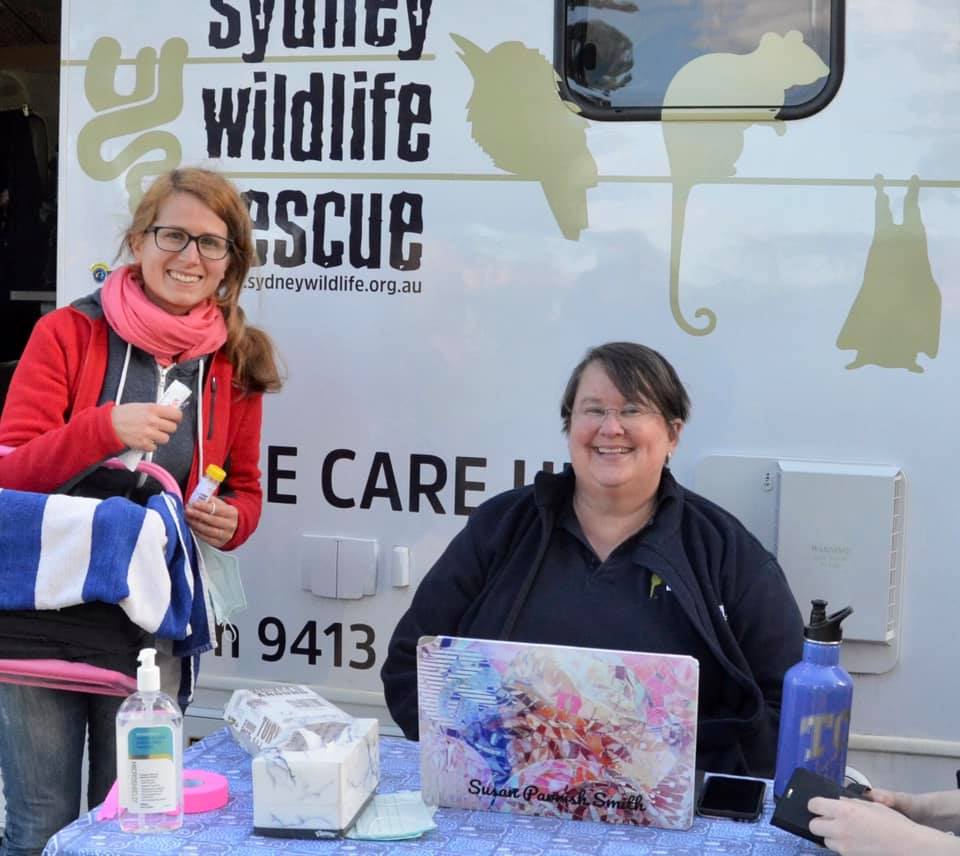
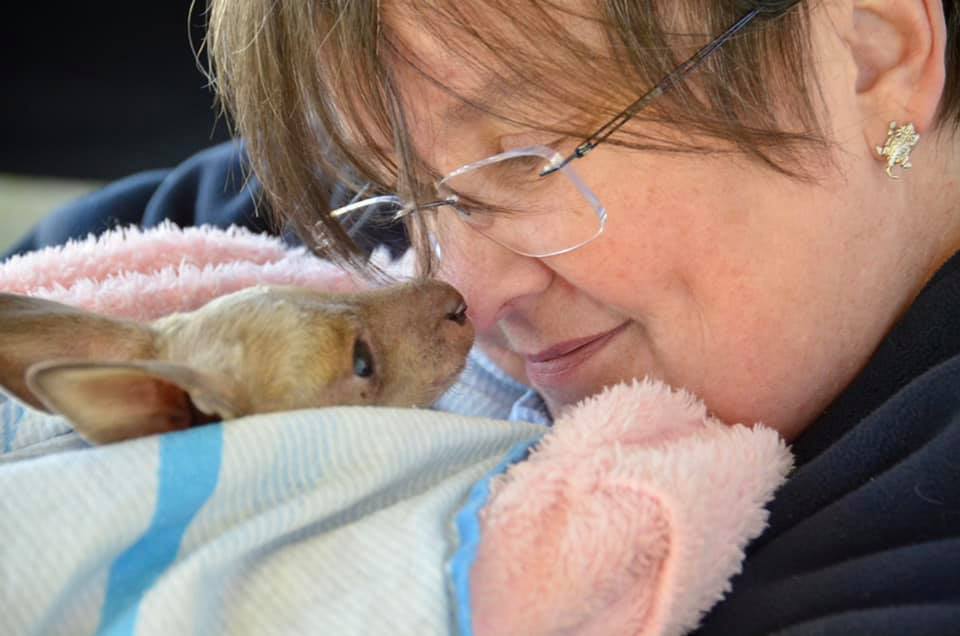
Pittwater Online spoke to Susan this week and asked her what she needs in this mission;
''We need anyone and everyone with two hands and a heart beat to come and join in the fruit chopping fun. The most exciting thing to know is that YOU DON'T NEED TO BE VACCINATED TO CHOP FRUIT!! If you might be able to assist in any way, whether it be a one off or if you're brave and willing to take on a regular weekly shift the bats will love you. We have a Kukundi mailing list so if you would like to receive monthly emails with the roster availabilities, please send us an email with your name, suburb and email address and we will add you to the list of CHAMPION choppers.
All new volunteers MUST undergo at least one induction shift with an experienced volunteer who will explain the procedures, where to find everything and most importantly introduce you to Turk, the resident Brush Turkey and Drax the Water Dragon who oversee the running of the facility. Email kukundi.bats@gmail.com or call Sydney Wildlife on 9413 4300 and leave your details with a ‘I want to help!’
''Today (Sunday) we will spend the day catching and assessing bats to ensure they haven’t had any further injuries. We will then do fly tests to assess how they are going. They have two weeks, if they can fly, to skedaddle. We will then close the cage and support feed them for two weeks on the outside, while adding more bats in we have a few males and females that need to go in.''
Sydney’s ubiquitous Grey-Headed Flying Fox (GHFF) is Australia’s largest flying fox species and, although apparently common, it was added to the Threatened Species Lists in 2001 as ‘Vulnerable to extinction’. Although surprising to many, it was well-justified based on population trends, when a decade of study revealed a 30% population drop. This information is of serious concern for the survival of the species – and the survival of our native forests, ecosystems and overall biodiversity.
Not all ‘threatened species’ are rare and population trends can warn us that intervention is required to prevent extinction occurring; especially with species that have a low reproduction rate. Flying Foxes (FFs) are cursed with the double-whammy of low fecundity and high mortality – meaning they can’t easily recover from either sudden population drops or from a gradual and continued downward population trend. Both are happening to FFs as a result of extensive clearing of habitat and consequent reduction in food resources; camp disturbances; increased severity and frequency of storms and droughts; and increased temperature spikes over 40 degrees.
Estimates indicate the GHFF population is only 5% of what it was prior to European settlement and, if recent declines continue, the species could be “effectively extinct” by the middle of this century. A species is effectively extinct when there are not enough animals left in the wild to perform their ecological role effectively.
But what is their ‘ecological role’? It is to pollinate our eucalypts and other native hardwoods which are the pioneer tree species that form the scaffolding of our native forests. These trees form the microclimates that create the habitats required for tens of thousands of other native species to survive.
Contrary to primary school biology, not all pollinators are birds, bees and butterflies and many of our native trees have evolved to ensure they are only pollinated at night. As FFs are the only significant nocturnal pollinators, they are designated as a ‘keystone species’ – a specialised and irreplaceable species performing a unique role. FFs can typically fly 50-100kms a night to forage and consequently are the only species that can disperse seed, pollinate trees, and spread genetic material across a landscape scale – all essential to ensure our native forests are genetically robust and capable of surviving climate change and disease. If we lose these wonderful animals we will, gradually but eventually, lose our native forests.''
The symbiotic mechanism is between FFs and our forest hardwoods is simple. Flowers are only pollinated by fresh pollen, which is only produced at night. To attract FFs, the trees also produce their main nectar load at night. The flowers of these hardwood trees are predominantly held above the canopy at the end of branches and are either cream or white – all adaptations to ensure they will attract a winged, nocturnal pollinator. ''
''The recent drought, bushfires and extreme temperatures have been devastating to our FF pups –generally born in spring and early summer.
''Flying foxes carers across all NSW are overloaded, well past care capacity and exhausted both physically and mentally. Additionally, as FFs are highly intelligent and incredibly affectionate, there is a highly personal impact on the emotional wellbeing of carers who are witnessing so much death.''
What can we do? We can all do something – here are my suggestions:
- Volunteer regularly at the Sydney Wildlife Rescue Office or on after hours phones if you can, so that exhausted carers can spend more time at home - either caring for their animals or trying to recover from exhaustion. This should be considered every Spring and Summer when carers are most likely to be overloaded.
- Ask if you can assist carers in any way. Even shopping, cooking, washing – not necessarily hands-on FF care.
- Volunteer at Kukundi Flying Fox Aviary (near the Lane Cove Rescue Office) when help is needed during creche season, especially with fruit chopping.
- Ask people with ‘death trap’ netting over their home fruit trees to either remove it or replace it with wildlife friendly netting. FFs and other wildlife species (including birds, possums, lizards and snakes) can be caught in the poorly-designed, wide-gauge netting that causes excruciating injuries and death. If you are not comfortable speaking to them personally then print off a brochure and pop it in the letterbox with a polite handwritten note (so they know it’s not junk mail). https://www.wildlifefriendlyfencing.com/WFF/Netting.html
- Water street trees or park trees (with a bucket and a soil-wetting agent), especially if they are flowering natives or have a heavy crop of native figs - and remember we have species that flower all year round, in season, for this reason. Do NOT fertilise a stressed tree. These trees are keeping Sydney’s FFs (and many other species) alive. Water around the drip line under the outer edge of the leaf canopy if they are large trees and try to soak the soil in at least one spot, rather than providing superficial water around the entire tree. Not all figs crop at the same time so check each tree. High numbers of foraging FFs indicate abundant fruit. The most common native species are Hills figs, Weeping Figs, and the Port Jackson and Morton Bay figs. I’ve saved several young verge box trees with just three litres of water a day for several days, then three litres twice a week. This will keep it alive until rain arrives should we experience again what we have experienced before.
- Give your Council a list of native street and park trees producing Flying Fox food and street trees that are about to die and ask them to introduce emergency support-watering. Send them this article, to explain the background to the request. Right now, the most important are the large native figs with a heavy crop of ripe figs and those with a heavy crop of green figs.
- Watering street trees may also save injury to people and damage to cars because stressed trees start to drop branches, some of them quite large.
- Write to politicians - be firm but polite. Ask for urgent action on climate change and for an urgent moratorium on the clearing of native vegetation, especially given the impact of the recent bushfires.
- When politicians say they support positive action on these issues email them (and their boss!) saying you support their stand (eg the NSW Minister for the Environment, Matt Kean on April 5 and Dec 10, 2019).
- Suggest to politicians and newspapers that volunteer wildlife carers who have taken time off work deserve the same financial support that has been extended to volunteers in the Rural Fire Service.
What can people do this week, right now, and into the future to be part of turning it all around too Susan?
''We are desperate of more volunteers. We’re currently cutting 30 kilos a fruit a day for them. We have 3 jobs to do on a daily basis, which can be up to 10 months a year. Clean the bottom of the aviary, we have to cut fruit, and it’s always going to be pears and apples; they make up 80% of fruit, the other 20% is rockmelon, honeydew melon or grapes, which are a last resort, and dress wounds and feed pups.
Right now we have 57 males in our large aviary – this is a six week process to support them to release stage and includes that 2 weeks in cage where they get their flying muscles going.''
Below runs an insight penned by Susan - our thanks to Edwina Laginestra, Lynleigh Grieg, Sam and Margaret Woods for the insights and wonderful photos.
Finally, please Email kukundi.bats@gmail.com or call Sydney Wildlife on 9413 4300 and leave your details with a ‘I want to help!’
Wouldn't it be great to see, in a few years, all the billions lost back in these now empty places again....
Rehabilitate The Rehabilitation Centre
By Susan Parrish Smith
Have you heard about the important role of flying foxes in the regeneration of the flora destroyed by the bushfires of 2019/2020? It definitely didn't make the local news. We saw the koalas rescued from the fires, the kangaroos with bandages on their feet and the wombats getting used to new habitats. The reporting on flying foxes killed by the fires or the ensuing heat stress event was shared about as much as the reporting on the native reptiles we lost - for example - the Eastern Brown snake or the Red Bellied Blake snake. Flying Foxes are a controversial subject in any given conversation and raising money for the care of these amazing animals is harder than keeping an Aussie inside on a nice sunny day. It's bloody difficult. But the Wildlife Heroes Project supported by the Foundation came to the rescue of many native animals affected by last year's bushfires with their Large Durable Asset Grant for NSW.
Sydney Metropolitan Wildlife Service (SMWS) is one of two organisations in Greater Sydney dedicated to the rescue, rehabilitation and release of injured native wildlife. SMWS is a total volunteer organisation and exists on donations from the public and grants. Ironically, flying foxes are down on the list of priorities when it comes to donations. The COVID-19 Pandemic moved them even further down the list of "cute animals to use on brochures." Grey Headed Flying Foxes (GHFF) are the largest of Australian bats. These amazing animals are important pollinators and seed dispersers, and are essential for forest pollination.
Remember the hundreds of thousands of hectares we lost in the recent bushfires? These animals perform much needed jobs in the dead of night while we all sleep soundly in our own beds. A GHFF can fly 50-100km one way each night to find the food to sustain them. Did you know their digestive systems process food in 20 (twenty!) minutes? That’s heaps of seeds shared along that 100km path they fly each night!
Remember our dedication to the rescue, rehabilitation and release of injured native animals? How are flying foxes injured? You never see them during the day, right? Many adults are caught in “wildlife unfriendly” netting or tangled in barbwire. Did you know there is safe netting for wildlife? If you can put your finger through a hole in your netting, that netting is guaranteed to injure or kill a flying fox.
A female flying fox has one job…well, two, if you count long distance pollinating. Her second job is carrying a flying fox pup to term, giving birth upside down, and catching the wiggling newborn in her wings. For the next 3-4 months, she is lactating to feed her pup which she carries attached to her nipple under her wing. Yep, 24/7! At least until they reach the age (around 8-12 weeks) when it can be left at the camp with the other pups, while parents make their 100km round trip to find food. Sometimes if a mum is startled by human intervention, she will quickly take flight hitting anything in her path. Often, her pup is hit by a tree branch, causing it to be pulled from its mum – or, it can fall on its own. When this happens, these pups come into care with our volunteers who raise the pup until it’s time to go to creche to learn how other bats live.
Creche…what and where is that?
In greater Sydney, there’s only one flying fox rehabilitation centre, and it’s located in Lane Cove National Park. There are two aviaries on the property: one for adults, and a smaller one for pups in creche. The large aviary was originally built as a flight aviary for birds. SMWS used it as a rehabilitation area for native birds, along with another area which had many habitats for recovering native wildlife. Eventually, the aviary was repurposed as a flight aviary for flying foxes, and SMWS received a grant to build the smaller aviary close to the large one. All of this was 10-15 years ago, and money has been very tight ever since. The flying foxes enjoy the upper half of the aviary where they hang in the sunlight during the day, move to the forward section of the aviary to eat the multiple kilograms of fruit cut by our volunteers, and then enjoy playing and flying from one end to the other. The problem is, the concrete floors have deteriorated over time, and are now as slippery – if not more slippery – as an ice rink. Trust me, it can be quite scary to clean the floors!
When Wildlife Heroes Project, supported by the Foundation for National Parks & Wildlife, announced their large durable asset grants, SMWS jumped at the chance to get our concrete floors repoured and sealed to keep our volunteers safe every day. Miracles can happen, which we saw when we were awarded a grant to “rehabilitate the rehabilitation centre!”
SMWS tried desperately to get the floors redone during our very short off season in November to December. We diligently worked with National Parks and Wildlife Service (NPWS) to satisfy their requirements since the aviaries sit on government land. We also hoped for as little disruption to the park visitors as possible, along with the café on the park grounds. Wildlife Heroes was extremely patient with us and offered any help we might need in bringing all the organisations together to succeed. Everyone tried to make it work, but we had more pups than expected. Additionally, many injured adults had “wintered” in volunteers’ homes and desperately needed back into the flight aviary to recuperate for their release. Sadly, it just didn’t come together in 2020. We accomplished minor repairs in preparation for the floorwork, cleared a massive amount of “junk” from enclosures, and even removed an airlock from the large cage. SMWS is working hard in conjunction with WIRES (who share responsibilities for flying foxes in care) and NPWS to find a week when no pups remain in creche and the adults have spent 2 weeks soft releasing to Greater Sydney.
Our hope is to begin work Monday, 19 April, 2021 to successfully replace worn slippery floors so our volunteers are safe and the flying foxes are fed each day they are in our care.
Update May 2021: the new floor is in!
